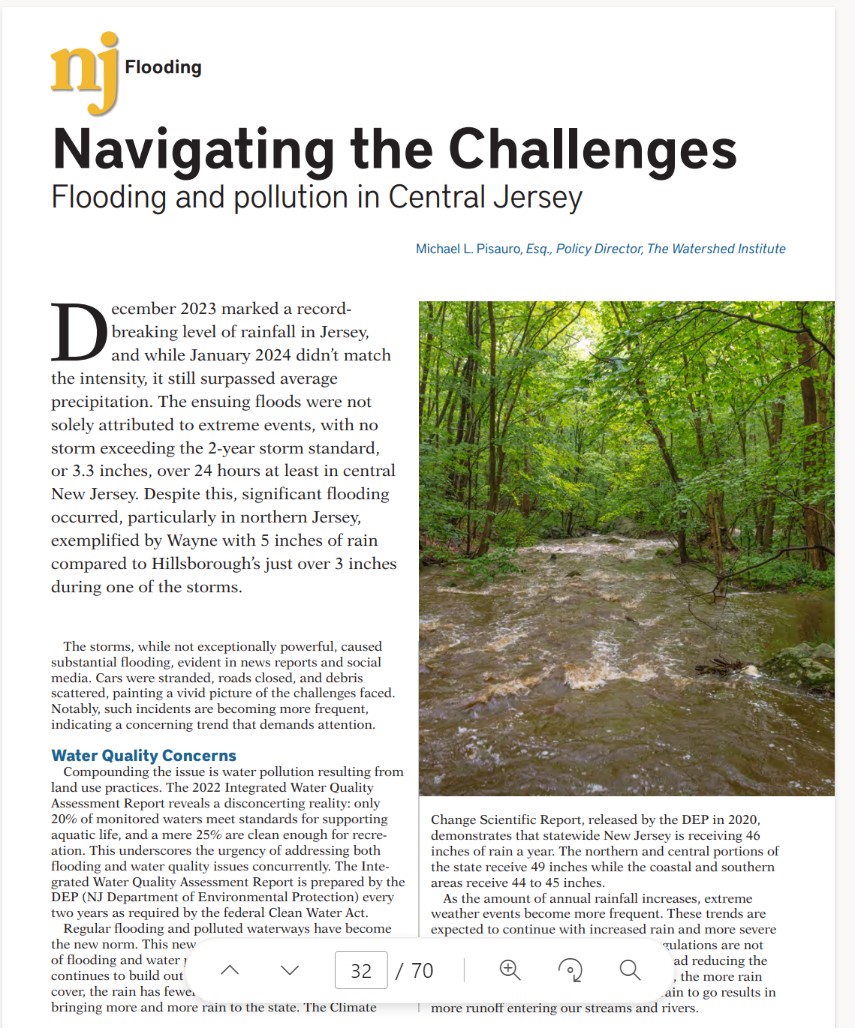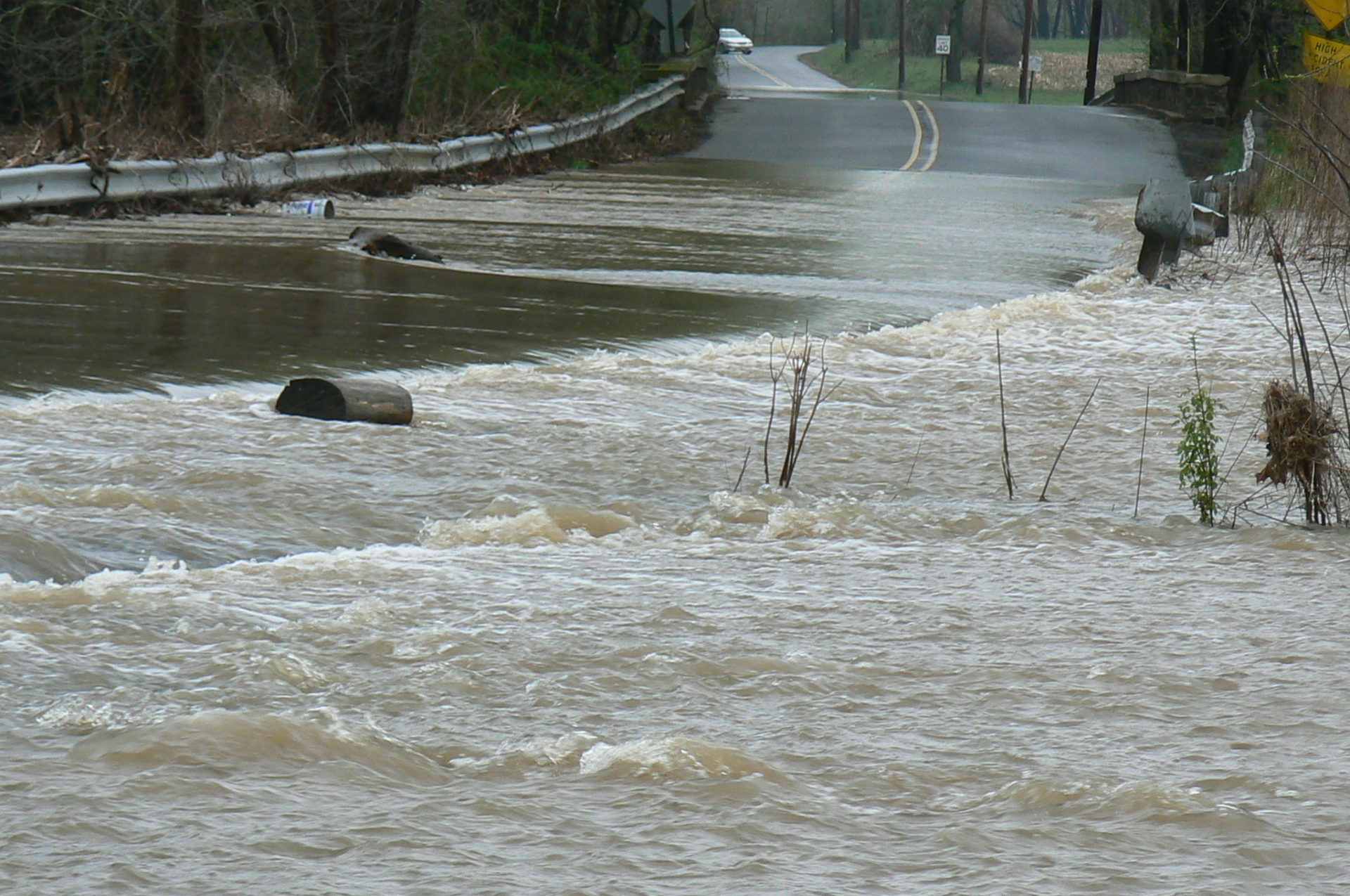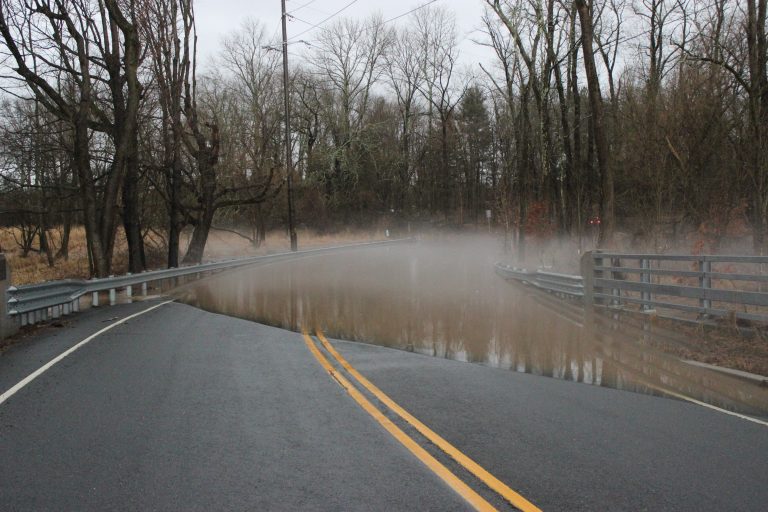 This article written by Policy Director Michael L. Pisauro, Esq. was published in the April 2024 issue of The League of Municipalities Magazine (www.njlm/NJMunicipalitites)
This article written by Policy Director Michael L. Pisauro, Esq. was published in the April 2024 issue of The League of Municipalities Magazine (www.njlm/NJMunicipalitites)
December 2023 marked a record-breaking level of rainfall in Jersey, and while January 2024 didn’t match the intensity, it still surpassed average precipitation. The ensuing floods were not solely attributed to extreme events, with no storm exceeding the 2-year storm standard or 3.3 inches over 24 hours at least in central New Jersey. Despite this, significant flooding occurred, particularly in northern Jersey, exemplified by Wayne NJ with 5 inches of rain compared to Hillsborough’s just over 3 inches during one of the storms.
The storms, while not exceptionally powerful, caused substantial flooding, evident in news reports and social media. Cars were stranded, roads closed, and debris scattered, painting a vivid picture of the challenges faced. Notably, such incidents are becoming more frequent, indicating a concerning trend that demands attention.
Water Quality Concerns
Compounding the issue is water pollution resulting from land use practices. The 2022 Integrated Water Quality Assessment Report reveals a disconcerting reality: only 20% of monitored waters meet standards for supporting aquatic life, and a mere 25% are clean enough for recreation. This underscores the urgency of addressing both flooding and water quality issues concurrently. The Integrated Water Quality Assessment Report is prepared by NJDEP (NJ Department of Environmental Protection) every two years as required by the federal Clean Water Act.
Regular flooding and polluted waterways have become the new norm. This new norm is unacceptable. The causes of flooding and water pollution are several. As NJ continues to build out with more and more impervious cover, the rain has fewer places to go. Climate change is bringing more and more rain to NJ. The Climate Change Scientific Report, released by NJDEP in 2020, demonstrates that statewide NJ is receiving 46 inches of rain a year. In the northern and central portions of the state receive 49 inches while the coastal and southern areas receive 44 to 45 inches. As the amount of annual rainfall increases, extreme weather events become more frequent. These trends are expected to continue with increased rain and more severe storms. In addition, our stormwater regulations are not reducing or controlling volume but instead reducing the speed at which runoff leaves a site. Thus, the more rain we experience, with less places for the rain to go results in more runoff entering our streams and rivers.
Multiple Causes, Diverse Solutions:
The multifaceted nature of these challenges necessitates a diverse set of solutions. New Jersey’s ongoing urban development exacerbates the problem, as more impervious cover limits the natural absorption of rainfall. The impact of climate change, increasing both the frequency and intensity of rainfall, further compounds the issue. The current stormwater regulations, while recently updated, fall short in controlling volume, focusing primarily on runoff speed.
Strengthen Municipal Stormwater Control Ordinances
While recent updates to NJ’s stormwater regulations and MS4 permit were much needed; they are not enough. Currently, our state regulations and many municipal stormwater control ordinances are not sufficient to address the current problem. Municipalities must adopt stronger ordinances. The regulations and ordinances refer to a quantity requirement, that is really a misnomer. Most development applications meet this requirement by either matching the rate the stormwater runs of a site or by reducing the rate. While the rate at which stormwater runoffs of a site has been slowed; overall the volume of stormwater that is running of a site has increased. This increased volume is the source of downstream flooding. The more a municipality is developed, the more volume of stormwater is funneled into our streams and downstream. Increased volumes contribute to water pollution by exacerbating stream erosion. Therefore, revising stormwater control ordinances to address volume through an onsite retention standard or by requiring other quantity reduction measures is critical.
We must also acknowledge that much of our state was developed before there were any stormwater management rules. This means for many of our older developments there is no stormwater management. Further, what was installed before 2004 does not meet current standards. This means that it is not providing the benefits we need modern stormwater management to provide rate reduction, groundwater recharge or water quality treatment. There are at least two solutions. First, when an older site is redeveloped the current requirements are easily met and do not provide much in the way of rate reduction or volume reductions mentioned above. A municipality can adopt a redevelopment standard that requires not only a reduction in runoff rates but also a volume reduction through onsite retention. This way we take the opportunity to manage previously unmanaged property thus reducing flooding. On opportunity is with older stormwater management systems that can be upgraded during a redevelopment to meet current standards once again providing some benefits.
Maintenance and Upgrades
The current MS4 permit requires that all stormwater management systems be maintained and that they function as designed. Municipalities must take opportunities to ensure these systems function and upgrade them to modern or enhanced standards. By retrofitting these basins, we can start to reduce the volume of runoff that is discharged into our waterways and to clean up that discharge. We will be taking advantage of existing systems instead of building all new ones. Municipalities can also encourage private property owners to take steps to improve their systems. Retrofitting these basins with green infrastructure can reduce the maintenance costs overall.
Restore Nature
In many places throughout NJ, we have altered the landscapes of our streams. Instead of gently sloping banks that allow water to overflow the banks and onto the flood plains, we have built in the flood plains, we have removed vegetation and caused the streams banks to be very steep. This does not allow the water to overtop the banks but forces increased volume downstream. By restoring the flood plains and vegetating the buffers we give flood water safer places to go and reduce downstream flooding. We also reduce the amount of stormwater that flows directly into our streams because the vegetative buffers use some of the water; slow and clean the remainder. Utilizing open space funding, Blue Acres, stormwater utilities, and other funding sources we can remove impervious cover and allow for the restoration. This provides the benefit of immediately removing people and property from harm’s way and helping protect downstream communities by giving the water a safer place to go. As we are restoring the damage we have caused, we can also take steps to minimize future damage. By adopting strong stream corridor ordinances, we can protect the existing flood plains and vegetated buffers. Ultimately, we protect people and property.
Collaborative Watershed Management:
Lastly, all our municipalities must start to work together to understand the problem and develop innovative solutions that benefit all. If we look at the watershed and the amount of impervious cover in that watershed and the flooding that occurs downstream, then adjust the existing zoning and impervious cover limits to reduce that flooding. Our communities may also work together to identify and fund restoration projects that may be too costly for any one community to afford. Or by working collaboratively lower cost projects can be identified that provide as much or more benefits than a go it alone process could provide.
Proposed Actions:
To address these concerns effectively, a series of actions is proposed:
Strengthen Municipal Stormwater Control Ordinances:
- Revise ordinances to address stormwater volume, not just speed.
- Inspect and repair existing stormwater management systems.
- Upgrade old systems to meet current or enhanced standards
- Adopt redevelopment standards requiring both runoff rate and volume reduction for older sites.
Zoning and Land Use Reassessment:
- Re-evaluate zoning and impervious cover limits in flood-prone areas.
- Utilize open space and Blue Acres funding to remove flood-prone properties.
Maintenance and Upgrades:
- Ensure regular maintenance of existing stormwater management systems.
- Retrofit basins with green infrastructure to reduce long-term maintenance costs.
Restore Nature:
- Restore floodplains and vegetative buffers to provide safer outlets for floodwater.
- Use funding sources to remove impervious cover and support restoration projects.
- Invest in restoring floodplains and vegetative buffers.
Collaborative Watershed Management:
- Encourage municipalities to work together, considering watershed-wide impacts.
- Adjust zoning and impervious cover limits collectively to reduce downstream flooding.
- Strengthen municipal stream corridor ordinances.
- Collaborate with neighboring municipalities to identify and address flooding sources.In conclusion, the cumulative effects of upstream actions require a comprehensive, collective response from municipalities. Recognizing the urgency and cost of the current situation is crucial, prompting a united effort to safeguard communities and ecosystems.




